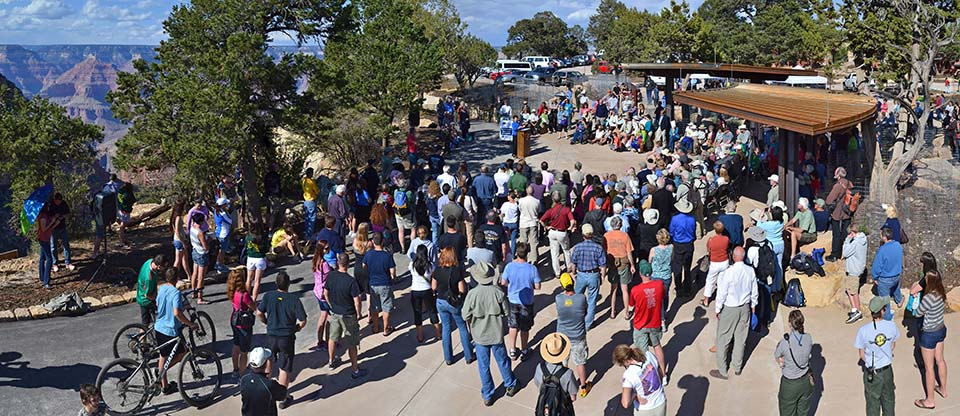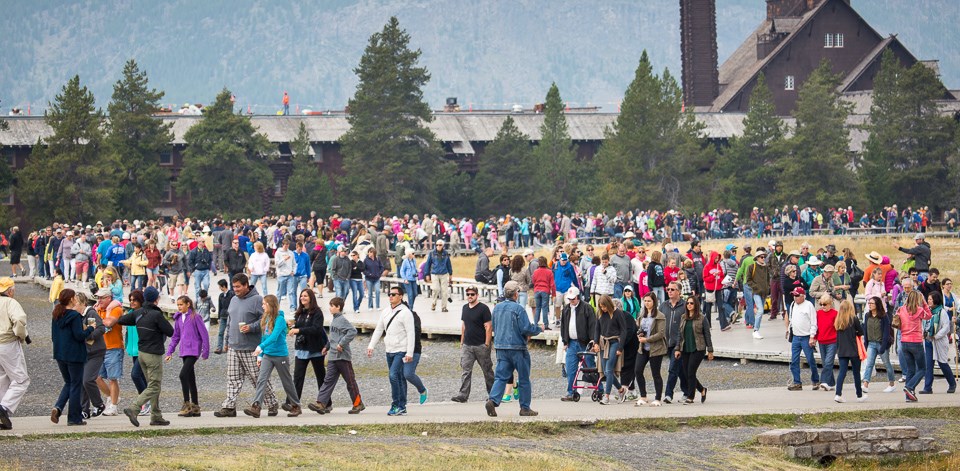In recent years, national parks, public recreation areas, and open spaces in the United States have seen dramatic increases in visitation. These trends, which have garnered national and international attention, can cause lines of traffic at entrance stations, overflowing parking lots, crowding on trails and at scenic attractions, and other issues.
A similar rise in tourism globally has resulted in what is now commonly referred to as “overtourism.” The impacts of overtourism have been felt in iconic cities around the world, including Venice, Barcelona, and Amsterdam. Scenes of crowding have been captured at world-class museums, cultural resource sites such as Machu Picchu, and even on the summit of Mount Everest.
As such, there has been growing awareness of the need to manage recreation and tourism use to physical, operational, social, and environmental capacities. In the time of COVID-19, crowding and capacity-related issues have taken on greater urgency. As parts of society begin to reopen in the United States and around the world, there are difficult questions about when and how to reopen and operate public parks, cultural venues, and tourist destinations while providing conditions for social distancing.
Keeping recreation destinations open while addressing increased visitation during COVID-19 presents novel challenges
When COVID-19 first began to spread across the United States, the Secretary of the Interior, David Bernhardt, directed the National Park Service (NPS) to waive entrance fees to support social distancing. However, increased visitation and a lack of social distancing shortly after the suspension of fees, along with changes in public health guidance, led many parks to close.
According to NPS.gov, at the time of this writing, more than 150 of the 419 national park units are still closed or not offering visitor services, and most national park buildings, facilities, and restrooms are closed to prevent the spread of COVID-19 among visitors and park staff.
Despite closures at the national level, demand for access to public lands has by no means diminished. While many state and local parks have closed playgrounds, sports fields, basketball courts, swimming pools, and visitor centers, some areas have remained open and experienced increased visitation.
Crowds have been reported at many parks in urban areas, such as New York City and Washington, DC. Over the first weekend in May, at least five state parks in Southern Utah closed early after hitting capacity. State parks in Montana saw a 60% increase in visitation in March and April 2020 as compared to visitation levels in 2018 and 2019.
In some states, such as Pennsylvania, increased visitation to state parks and state forests has been associated with increased vandalism, illegal dumping, and property damage. South Pointe Park in Miami Beach was closed less than one week after reopening after nearly 8,000 verbal face-covering warnings and social distancing warnings from the police department went unheeded.
Altercations due to enforcement are not unheard of. A video that went viral in early May featured a local park ranger in Austin, Texas, being pushed into a lake as he was explaining the need for social distancing. As restrictions are gradually loosened, these incidents point to the need for proper protection and enforcement mechanisms to help mediate interactions between recreation site managers and the public.
Reopening recreation destinations requires innovative management actions to address capacity and crowding
In conjunction with the reopening of businesses and public spaces, the Department of Interior has directed NPS to reopen national parks “as rapidly as possible.” Many national parks, including Yellowstone, Grand Canyon, Great Smoky Mountains, Capitol Reef, Everglades, and Bryce Canyon, have begun moving forward with a phased reopening in coordination with federal, state, and local health authorities. Parks are using a variety of mitigation measures to keep the public and staff safe; for example, Yellowstone has released their three-phase plan for reopening that includes installing protective barriers, increasing messaging, and controlling visitor access to certain park areas.

Visitors at the Grand Canyon National Park in 2013 at the Bright Angel Trailhead. The park was one of the last national parks to remain open during the early weeks of the pandemic. After closing in early April, parts of the park began reopening on May 15. Source: NPS.gov
At Great Smoky Mountains National Park, reopening has been gradual and included additional changes to keep the public and staff safe. According to a recent New York Times piece, these changes have included “measures to disinfect public buildings and restrooms, install plexiglass barriers at visitor centers, reduce group sizes and require maintenance workers to wear personal protective equipment.”
Still, some public health experts are concerned that visitors may exacerbate the spread of COVID-19 by traveling across state lines to visit national parks. Indeed, rangers at both Yellowstone and Great Smoky Mountains observed many out-of-state license plates and a lack of social distancing during their first days of reopening. For this reason, a responsible reopening of national parks requires careful consideration of how management objectives can incorporate public health guidance and what the impact of these changes will be on visitors’ behavior.
Some state and local parks are already adapting. In early May, state parks in Texas, Massachusetts, New Jersey, South Carolina, and Connecticut proactively lowered their parks’ capacity thresholds, defined by the total number of vehicles allowed at one time, to support social distancing.
State parks in Connecticut have limited pedestrian entry to discourage people from parking outside of the park and walking in, and some trails in New Jersey are being monitored to accommodate social distancing.
While some local parks may not have the technology or staff to provide real-time crowding updates, others are publicizing park crowding levels online. For example, Colorado Springs is helping residents make informed choices about their recreation destinations by maintaining a public website of crowding levels based on ranger assessments.
COVID-19 requires incorporating health and safety guidelines into traditional management decisions about visitor capacities
Given the threat and challenges posed by COVID-19, public recreation providers must incorporate public health and safety guidelines into visitor use and capacity decisions. Many of the changes necessitated by these considerations will affect the number of people who can safely be accommodated in buildings and facilities, programs and events, trails and overlooks, and even staff housing.
Still, while managing use levels and capacities has never been more urgent, methods to establish capacities that protect the health of visitors and staff are not all that dissimilar from those that protect natural resources, cultural resources, and visitors’ experiences.
For instance, at Castillo de San Marcos National Monument, RSG’s research revealed that visitor density and crowding in the fort negatively impacted visitors’ abilities to engage with interpretive exhibits and information. The park is now working with us to apply these data to develop COVID-19-related capacities that follow social distancing guidelines and other health and safety recommendations.
Reopening and operating recreation and tourism venues in the context of COVID-19 also provides an opportunity to pilot crowding management strategies that could dramatically improve conditions but have lacked widespread, urgent support until now. For example, Rocky Mountain National Park is proposing a timed entry permit system that would manage the number of people in the park at one time during the first phase of reopening to enable safe visitation levels and flow. Managers and facility operators may consider setting up similar timed permit systems, instituting one-way patterns of visitor flow, establishing no-contact fee collection methods, sharing information about new policies on social media, and encouraging or requiring visitors to stagger use across locations and times of the day.
Setting, monitoring, communicating, and enforcing crowding-based capacities now and during each phase of reopening will be critical for ensuring the protection of visitors and staff. If these processes are carefully monitored, they may also inform future management strategies to protect resources and visitors’ experiences. With these insights, recreation and tourism professionals will be better equipped to manage visitor use now and in the future.


